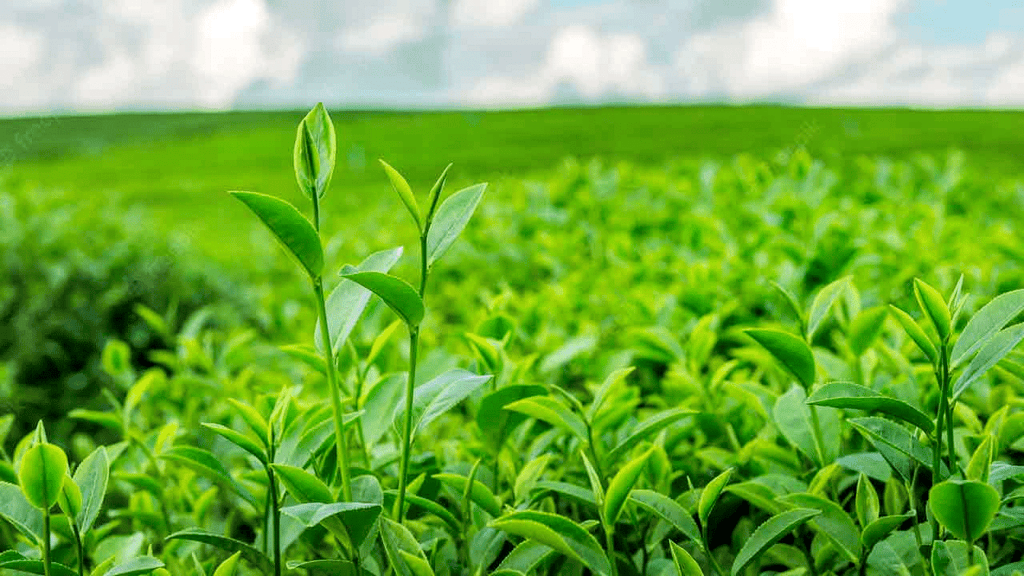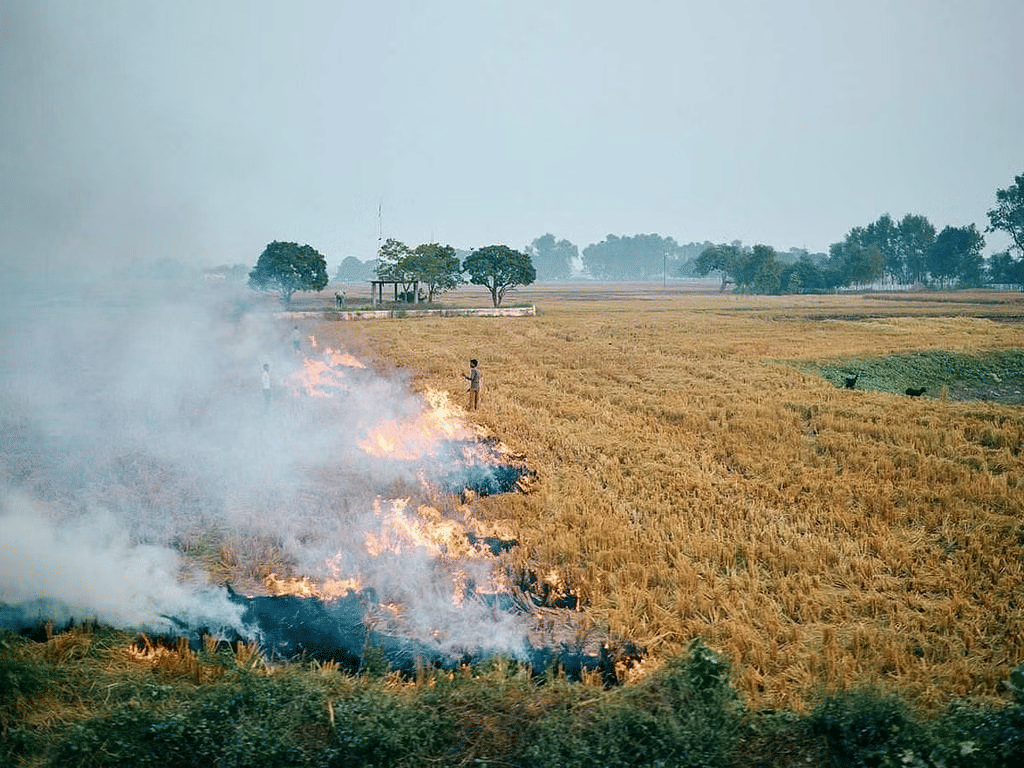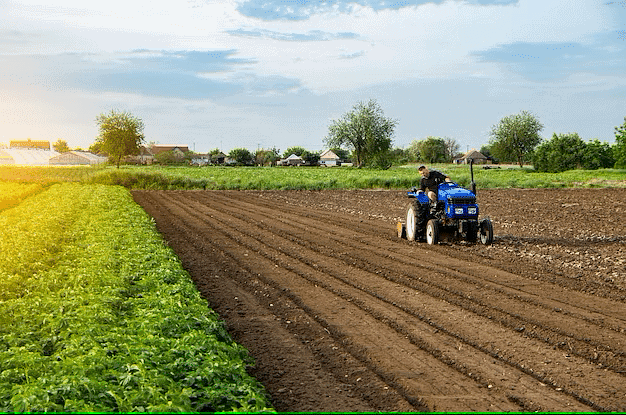Class 8 Exam > Class 8 Notes > Social Studies (SST) Class 8 > NCERT Summary: Agriculture
Agriculture Summary Class 8 NCERT Summary Chapter 4
| Table of contents |

|
| Introduction |

|
| Agriculture |

|
| Types of Farming |

|
| Major Crops |

|
| Agricultural Development |

|
| A farm in India vs a farm in USA |

|
Introduction
- Primary Activities: It include all those connected with extraction and production of natural resources.
- Examples: Agriculture, fishing and gathering.
- Secondary Activities: These are concerned with the processing of these resources.
- Examples: Manufacturing of steel, baking of bread and weaving of cloth.
- Tertiary Activities: These provide support to the primary and secondary sectors through services.
- Examples: Transport, trade, banking, insurance and advertising.

Agriculture
- Agriculture is a primary activity.
- It includes growing crops, fruits, vegetables, flowers and rearing of livestock.
- In the world, 50 percent of population is engaged in agricultural activity.
- Two-thirds of India’s population is still dependent on agriculture.
- Favourable topography of soil and climate are vital for agricultural activity.
- The land on which the crops are grown is known as arable land.
Farm System
- The important inputs of agriculture are seeds, fertilisers, machinery and labour.
- The operations needed are ploughing, sowing, irrigation, weeding and harvesting.
- The outputs from the system include crops, wool, dairy and poultry products.
Types of Farming
Farming can classified into two main types, depending upon the geographical conditions, demand of produce, labour and level of technology:
- Subsistence farming
- Commercial farming
Subsistence Farming
- This type of farming is practised to meet the needs of the farmer’s family.
- Low levels of technology and household labour are used to produce on small output.
- Subsistence farming can be further classified as:
- Intensive subsistence farming
- Primitive subsistence farming
Intensive subsistence farming
- In this type of farming, the farmer cultivates a small plot of land using simple tools and more labour.
- Climate with large number of days with sunshine and fertile soils permit growing of more than one crop annually on the same plot.
- Rice is the main crop.
- Other crops include wheat, maize, pulses and oilseeds.
- This farming is prevalent in the thickly populated areas of the monsoon regions of south, southeast and east Asia.
Primitive subsistence farming
It includes:-Shifting Cultivation
- It is practised in the thickly forested areas of Amazon basin, tropical Africa, parts of southeast Asia and Northeast India.
- These are the areas of heavy rainfall and quick regeneration of vegetation.
- Method: A plot of land is cleared by felling the trees and burning them. The ashes are then mixed with the soil and crops are grown. After the soil loses its fertility, the land is abandoned and the cultivator moves to a new plot.
- Shifting cultivation is also known as ‘slash and burn’ agriculture.
Nomadic herding
- It is practised in the semi-arid and arid regions of the Sahara, Central Asia and some parts of India, like Rajasthan and Jammu and Kashmir.
- Method: In this type of farming, herdsmen move from place to place with their animals for fodder and water, along defined routes.
- Sheep, camel, yak and goats are most commonly reared.
- They provide milk, meat, wool, hides and other products to the herders and their families.
 Nomadic herding
Nomadic herding
Commercial Farming
- In commercial farming crops are grown and animals are reared for sale in market.
- The area cultivated and the amount of capital used is large.
- Most of the work is done by machines.
- Commercial farming includes
Commercial grain farming
- Crops are grown for commercial purpose.
- Common crops: Wheat and maiz.
- Major areas: temperate grasslands of North America, Europe and Asia.
- Severe winters restrict the growing season and only a single crop can be grown.
Mixed farming
- The land is used for growing food and fodder crops and rearing livestock.
- Areas: Europe, eastern USA, Argentina, southeast Australia, New Zealand and South Africa.
Plantations
- Only single crops of tea, coffee, sugarcane, cashew, rubber, banana or cotton are grown.
- Large amounts of labour and capital are required.
- The produce may be processed on the farm itself or in nearby factories thus requiring transportation facilities.
- Areas: Tropical regions of the world.
- Rubber in Malaysia, coffee in Brazil, tea in India and Sri Lanka are some examples.
 Modern plantation
Modern plantation
Major Crops
- Rice: Major food crop of the world.
- It is the staple diet of the tropical and sub-tropical regions.
- Rice needs high temperature, high humidity and rainfall.
- It grows best in alluvial clayey soil, which can retain water.
- China leads in the production of rice followed by India, Japan, Sri Lanka and Egypt.
- Wheat: Wheat requires moderate temperature and rainfall during growing season and bright sunshine at the time of harvest.
- It thrives best in well drained loamy soil.
- Wheat is grown extensively in USA, Canada, Argentina, Russia, Ukraine, Australia and India.
- In India it is grown in winter.
- Millets: They are also known as coarse grains and can be grown on less fertile and sandy soils.
- It is a hardy crop that needs low rainfall and high to moderate temperature and adequate rainfall. → Jowar,bajra and ragi are grown in India.
- Other countries are Nigeria, China and Niger.
- Maize: Maize requires moderate temperature, rainfall and lots of sunshine.
- It needs well-drained fertile soils.
- Maize is grown in North America, Brazil, China, Russia, Canada, India, and Mexico.
- Cotton: Cotton requires high temperature, light rainfall, two hundred and ten frost-free days and bright sunshine for its growth.
- It grows best on black and alluvial soils.
- China, USA, India, Pakistan, Brazil and Egypt are amin producers.
- It is one of the main raw materials for the cotton textile industry.
- Jute: Also known as ‘Golden Fibre’.
- It grows well on alluvial soil and requires high temperature, heavy rainfall and humid climate.
- This crop is grown in the tropical areas.
- India and Bangladesh are the leading producers.
- Coffee: Coffee requires warm and wet climate and well-drained loamy soil.
- Hill slopes are more suitable for growth of this crop.
- Brazil is the leading producer followed by Columbia and India.
- Tea: Tea is a beverage crop grown on plantations.
- It needs well-drained loamy soils and gentle slopes.
- Requires cool climate and well distributed high rainfall throughout the year for the growth of its tender leaves.
- Labour in large number is required to pick the leaves.
- Kenya, India, China, Sri Lanka produce the best quality tea in the world.
Agricultural Development
- It refers to efforts made to increase farm production in order to meet the growing demand of increasing population.
- How to achieve agricultural development
- Increasing the cropped area
- Increasing the number of crops grown
- Improving irrigation facilities
- Use of fertilisers and high yielding variety of seeds
- The ultimate aim of agricultural development is to increase food security.
A farm in India vs a farm in USA
 Farm in India vs Farm in USA
Farm in India vs Farm in USA
The document Agriculture Summary Class 8 NCERT Summary Chapter 4 is a part of the Class 8 Course Social Studies (SST) Class 8.
All you need of Class 8 at this link: Class 8
|
69 videos|431 docs|46 tests
|
FAQs on Agriculture Summary Class 8 NCERT Summary Chapter 4
| 1. What are the major crops grown in commercial farming? |  |
Ans. Major crops grown in commercial farming include wheat, rice, maize, sugarcane, cotton, and oilseeds.
| 2. How does agricultural development impact the economy of a country? |  |
Ans. Agricultural development can positively impact the economy of a country by increasing food production, creating employment opportunities, improving rural infrastructure, and boosting exports.
| 3. What are the differences between a farm in India and a farm in the USA? |  |
Ans. Some differences between a farm in India and a farm in the USA include the size of farms, technology used, types of crops grown, irrigation methods, and government support.
| 4. What are the different types of farming mentioned in the article? |  |
Ans. The types of farming mentioned in the article include subsistence farming and commercial farming.
| 5. How can farmers improve agricultural productivity on their farms? |  |
Ans. Farmers can improve agricultural productivity on their farms by implementing modern farming techniques, using high-quality seeds, proper irrigation methods, and efficient pest control measures.
Related Searches
















